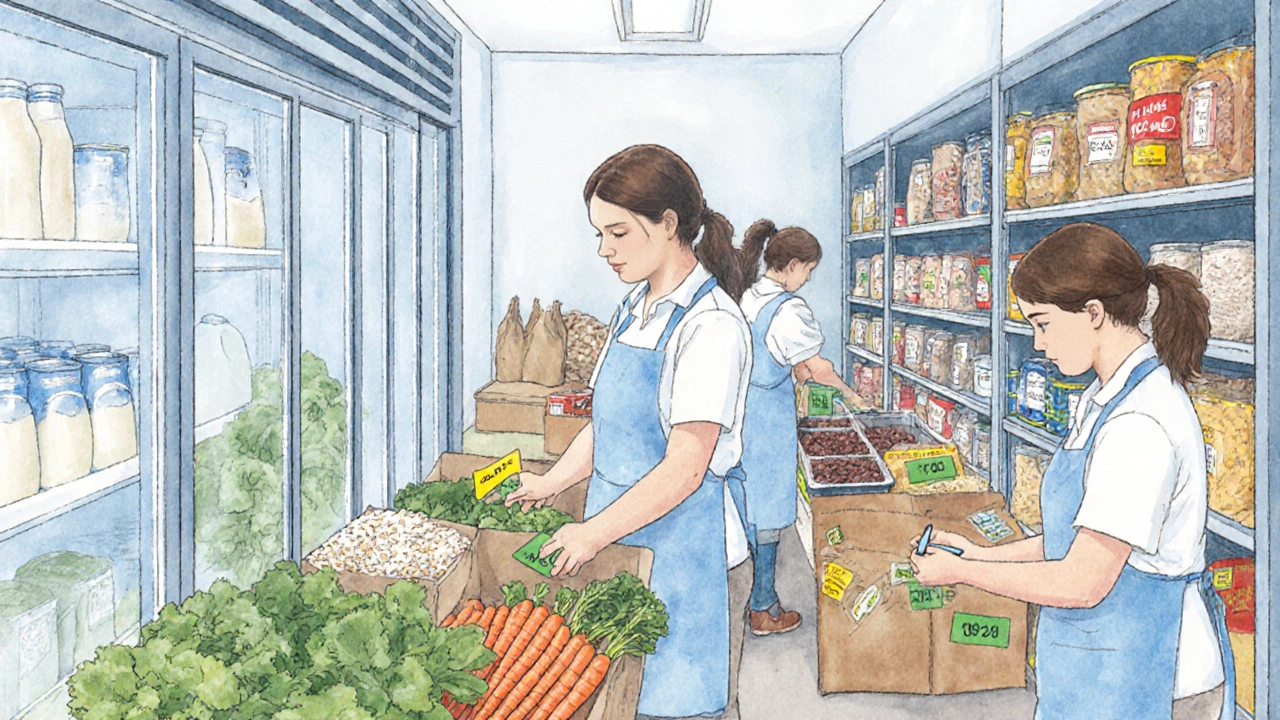Local Food Pantry Operations Simulator
This simulation demonstrates the key stages of how a local food pantry operates from receiving donations to serving families in need.
From supermarkets, farms, individuals, and grants
Separate perishables, label items, store properly
Use systems to monitor stock levels and expiry dates
Verify eligibility, assign bags, allow choice selection
- Low Income Threshold - Households earning below 60% of median income
- Benefit Recipients - Universal Credit, Jobseeker’s Allowance, Child Tax Credit
- Temporary Hardship - Job loss, medical bills, housing crisis
Click "Start Simulation" to see how a typical pantry operation works.
- Wear clean, non-slip shoes
- Bring a reusable water bottle
- Know the 3-step sorting process
- Familiarize yourself with inventory apps
- Respect client privacy
Ever wondered what happens behind the scenes when you walk into a community pantry and pick up a bag of groceries? Understanding the inner workings can help you decide where to donate, how to volunteer, or simply feel confident that the system works for you. Below is a step‑by‑step look at the typical flow of a local food pantry - from the moment food arrives to the moment it reaches a family’s kitchen.
What Is a Local Food Pantry?
Local food pantry is a community‑based outlet that distributes donated food to individuals and families facing food insecurity. It usually operates out of a church hall, community centre, or a dedicated building, and is part of a larger network of food banks that source bulk supplies.
Who Runs It?
The backbone of any pantry is its community volunteers. These are everyday people - retirees, students, parents - who give a few hours each week to sort, stock, and hand out food. A small steering committee often handles fundraising, partnership building, and compliance with health regulations.
Where Do the Foods Come From?
Donations land on the pantry’s doorstep from several donation sources:
- Supermarkets that pull near‑expiry stock.
- Local farms offering surplus produce.
- Individual donors who drop off canned goods.
- Charitable grants that fund bulk purchases.
How Are Items Sorted and Stored?
Once the boxes arrive, volunteers perform a quick visual inspection to ensure nothing is damaged or past its best‑by date. Then the pantry follows a distribution model that usually looks like this:
- Separate perishables (fruits, vegetables, dairy) from non‑perishables.
- Place items into temperature‑controlled zones - refrigeration for dairy, a dry room for canned goods.
- Label each pallet with a simple code indicating type, expiration, and source.
To keep track, many pantries now use a basic inventory management system. This can be a spreadsheet or a free cloud‑based app that logs quantities, dates received, and dates distributed.
How Distribution Works
When a client arrives, the pantry follows these steps:
- Check eligibility: Staff verify the client meets the eligibility criteria - usually a proof of low income, benefit statement, or a referral from a social worker.
- Assign a bag size based on household size and dietary needs.
- Allow the client to pick items from a pre‑arranged “choice” shelf, encouraging dignity and variety.
- Record the transaction in the inventory system to maintain stock accuracy.
This client‑first approach helps reduce waste and ensures families receive foods they actually want to eat.

Who Can Get Help?
Eligibility can differ by region, but most pantries stick to a few core guidelines:
- Households earning below a set income threshold (often 60% of the median income).
- Recipients of benefits such as Universal Credit, Jobseeker’s Allowance, or Child Tax Credit.
- Individuals experiencing temporary hardship - loss of job, unexpected medical bills, or housing crisis.
If you’re unsure, simply call the pantry; staff will guide you through the paperwork.
How Volunteers Keep Things Running
Beyond sorting and distribution, volunteers also manage:
- Shelf‑life tracking: Using coloured stickers to mark items that will expire within 30 days, prompting a “quick‑sell” to clients.
- Fundraising events - bake sales, community runs - that fund transport costs.
- Outreach - connecting with local schools, churches, and businesses for fresh donations.
Training sessions, often just an hour long, cover food safety, respectful client interaction, and basic record‑keeping.
Common Pitfalls & How to Avoid Them
Many new pantries stumble over a few recurring issues:
| Challenge | Impact | Solution |
|---|---|---|
| Irregular donation flow | Stockouts, client disappointment | Set up recurring agreements with supermarkets and local farms. |
| Poor inventory tracking | Food waste, over‑ordering | Adopt a simple digital log; train volunteers weekly. |
| Unclear eligibility | Exclusion of needy families | Publish clear criteria on the pantry’s website and flyers. |
| Volunteer burnout | Staff turnover, service gaps | Rotate shifts, recognize contributions publicly. |
Quick Checklist for New Volunteers
- Wear clean, non‑slip shoes and a name badge.
- Bring a reusable water bottle - stay hydrated.
- Know the three‑step sorting process: perishable, non‑perishable, donation source.
- Familiarize yourself with the inventory app before your shift.
- Respect client privacy - no photos or personal details shared.
Next Steps for Readers
If you’re a potential donor, reach out to your local pantry and ask about bulk drop‑off dates. If you’re considering volunteer work, sign up for a short orientation session - most pantries need just a few hands on a Saturday morning. And if you or someone you know might need assistance, locate the nearest pantry using council resources or community notice boards.
Frequently Asked Questions
What is the difference between a food bank and a local pantry?
A food bank typically operates on a regional or national level, sourcing large quantities of food and distributing them to smaller outlets. A local pantry is one of those outlets, delivering food directly to individuals in a specific neighbourhood.
Do I need proof of income to receive food?
Most pantries ask for a brief proof - a benefits statement, recent payslip, or a referral from a social service. Some also operate on a “no‑questions‑asked” basis during emergencies.
Can I donate non‑food items?
Yes, items like cleaning supplies, personal hygiene products, and pet food are often welcome, especially if they have a long shelf‑life.
How often are pantry supplies refreshed?
It varies by location, but most pantries receive new stock weekly or bi‑weekly, depending on donation flow and regional food‑bank deliveries.
What safety measures are in place for perishable foods?
Perishables are stored in refrigerated units at 4°C (39°F) or below, and volunteers check temperature logs daily. Items nearing expiration are flagged and either distributed quickly or donated to shelters that can use them immediately.
